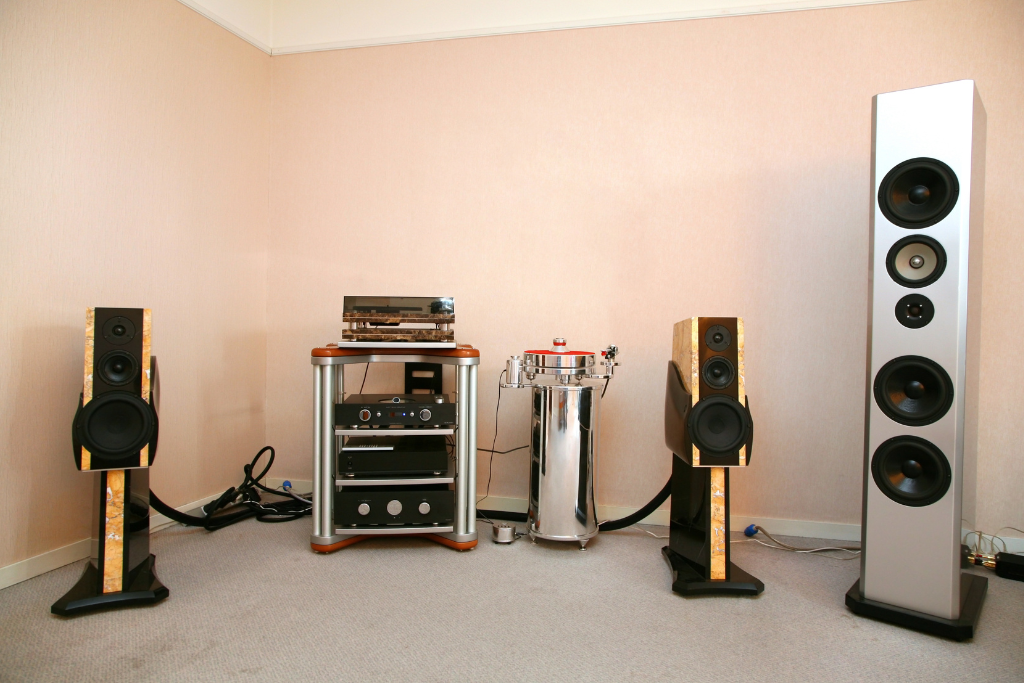The Great Audio Debate: Subwoofers vs. Speakers – Differences

Everyone agrees that the very first component you presumably choose when progressively building your home theater system is indeed a set of speakers. However, a powered subwoofer is also one of the essential elements of a full audio system, regardless of whether your arrangement is for films, music, games, or all of the above.
To create an outstanding sound system, particularly intended for vocalists and bands, you will traditionally have an arrangement that includes speakers and subwoofers in addition to tweeters, mid-ranges, and woofers. The reason is that each of these components handles a diverse range of notes and sounds, and when combined, the full spectrum of sound is covered.
Professionals at Linked Security are here to address some common concerns regarding the distinctions between subwoofers and speakers and how they can enhance your home entertainment experience. So, let’s delve into further specifications and find out more!
What Are Subwoofers?
The subwoofer is the speaker that provides the lower frequencies, particularly 20–200 Hz, that a traditional two-channel or surround sound system can’t represent. A subwoofer enables you to feel the tone, whereas your bookshelf or floor-standing speakers may only let you perceive the sound.
By relieving the workload from the loudspeakers and enhancing your system as a whole, a great subwoofer may assist in enhancing your general quality of enjoyment. In addition to expanding the soundstage and improving the stereo image, the dynamics are also becoming more appealing. A subwoofer helps create a more lively, all-encompassing sound, regardless of whether you love listening to music or watching dialogue-driven films.
Types of Subwoofers
If you are considering buying subwoofers, you will have to decide between an active and passive configuration. The active subwoofer has an amplifier integrated right into it, which sets it apart from its counterparts.
While slightly more expensive than passive ones, it can significantly enhance sound quality. An active subwoofer differs from a passive subwoofer by having an internal amplifier, whereas the latter merely contains a subwoofer driver and needs an external amplifier.
Subwoofers can also be classified into different categories based on their features and functions, such as:
- Ported subwoofer
- Sealed Cabinet
- Passive Radiator
- Front and Down Firing Types of Subwoofers
- Bandpass Subwoofers
- Horn Loaded Subwoofers
Key Features and Specifications
The construction of a subwoofer is typically a wooden or plastic loudspeaker enclosure that is equipped with one or more woofers. Numerous subwoofer variations can be developed depending on how the woofers are positioned. Depending on their efficiency, height, price, power handling, and distortion characteristics, different subwoofer variants can be identified.
Depending on its intended use, a subwoofer can produce a variety of frequencies. Therefore, a subwoofer used for home use would usually have a frequency range of 20 to 200 Hz, whereas one used for professional sound would have a frequency range of less than 100 Hz. Some subwoofers operate at a frequency under 80 Hz.
Pros & Cons of Subwoofers
Pros
The presence of a subwoofer in your audio system has numerous noteworthy benefits. The deeper bass serves as the primary advantage, and the mid-range sound is also improved since the interconnected speakers are not under as much stress.
Your sound system will sound considerably better across all frequencies if you add a subwoofer. You can increase the intensity without experiencing distortion since the subwoofer puts less strain on your speakers. Audio from the subwoofer is also crisper and clearer than that from full-range speakers because it concentrates on a different frequency range than the speakers do.
Cons
Although subwoofers enhance sound clarity, they can still have some drawbacks, such as the inability to be used independently. It only works with a speaker that is attached. Subwoofers are sometimes poorly constructed, and this can even make them challenging to set up.
What Are Speakers?
Conversely, a speaker is a loudspeaker, which is a type of electro-acoustic transducer that transforms electrical signals into sound. So, the speaker’s basic operating concept is that it moves in time with changes in an electric signal to transmit sound waves via either water or air. The speakers play a crucial role in comparing audio systems since they produce the most distortion and audible variations.
Subwoofers and speakers differ from one another primarily in terms of the frequency range. While speakers may convey high frequencies, such as the mid- and treble range, to perfection, subwoofers are only utilized for the lowest section of the audio spectrum and are ideal for bass sounds.
Types of Speakers
According to their physical characteristics, such as size and weight, as well as their connectivity, frequency range, applications, and locations, speakers can be divided into many types. Taking into account all the aforementioned characteristics, speakers can be classified as:
- Bookshelf Speakers
- Tower Speakers
- Soundbar speakers
- Built-in speakers
- In-ceiling and in-wall speakers
- Outdoor speakers
- Portable speakers
If we prioritize primary categories of speaker dimensions and placement, we might mention bookshelf speakers, which are compact speakers that can be set up on a shelf or stand and are extensively employed in home audio arrangements.
Tower speakers, commonly referred to as floor-standing speakers, are bigger than bookshelf speakers and can either be attached to a wall or stand on the floor. Due to their larger size, which allows for broader drivers with greater performance capabilities, these kinds of speakers typically have a better listening experience than bookshelf speakers.
Key Features and Specifications
Specifications for speakers include input impedance for the most effective and accurate sound reproduction, frequency response, speaker size, and speaker weight. Sound pressure level, also known as the maximum or nominal amount at a particular frequency within the dynamic range, nominal input power, and speaker weight is also included.
The case, chassis, or enclosure used to house speakers is frequently built of composite, metal, wood, or plastic. Air is kept from escaping through sealed or acoustically suspended enclosures, resulting in fluctuating internal air pressure.
Some suppliers categorize speakers based on their intended use. For example, professional-grade audio speakers are specifically designed for recording, television, radio, and live sound events like concerts or sporting events. Moreover, other speakers are water and fire-resistant.
Pros & Cons of Speakers
Pros
Speakers have several benefits, starting with the pricing. Even though you might want to change the factory-installed speakers, the parts are frequently less expensive than adding a subwoofer. More significantly, while the bass will not be as strong, you can still hear the majority of frequencies through regular speakers.
A subwoofer might not be required, depending on how you intend to use the speakers and the genre of music you enjoy. Excellent speakers with strong low-end frequency responses, like the Polk Audio T15, might also suffice.
Cons
There are very few drawbacks as long as you are using high-quality speakers. The main one is that since speakers are made to generate higher-range frequencies, you won’t be able to hear deep bass as well. The sub-bass sounds can seem barely audible, fuzzy, muddy, or just plain unclear when speakers are used to broadcasting lower-range frequencies. More significantly, excessive volume can result in blurring.
Subwoofers vs Speakers: Differences
Speakers and subwoofers vary from one another primarily in terms of the frequency spectrum, design and dimensions, and power and amplification.
- Frequency spectrum: Speakers are built to produce a broad range of frequencies, from high to low to midrange. Subwoofers, on the other hand, are designed exclusively to create low-frequency sounds, usually below 100Hz.
- Design and dimensions: Contrary to subwoofers, speakers are typically more compact and movable. Bookshelf, floor-standing, and in-wall speakers are just a few of the many forms and styles that are available. However, since subwoofers are considerably larger and need more space for operation. The majority of the time, they are created to function either independently or as a component of a more comprehensive home theater system.
- Power and amplification: To function properly, subwoofers should be paired with a compatible amplifier as they require more power to create low-frequency sounds. On the other hand, speakers can frequently be powered immediately by an audio source like a receiver or amplifier.
How to Choose Between Subwoofers and Speakers
- Determine your needs
Knowing the fundamental distinctions between subwoofers and speakers will help you choose the right one for your unique audio requirements. A subwoofer is the best option if you want to improve your audio’s bass tones. A speaker might be a superior option if you want a sound that covers a wider frequency range and is more all-encompassing.
Compared to subwoofers, speakers are more versatile and portable due to their ability to produce a broader range of experiences and come in a variety of sizes and shapes.
- Consider the space
Speakers can be compact enough to be put close to a TV or stereo system while still having the volume to fill a room. Although deep bass subwoofers frequently appear in a variety of sizes, they are all large and clumsy by nature. If your living arrangements demand that they not take up an excessive amount of space, you might want to measure before making a purchase.
- Think about the budget
In comparison to speakers, subwoofers have more strength and bass response. When the deep rumble of bass is desired, they are particularly helpful in home theater systems. Subwoofers, on the other hand, may cost more money and take up more space than conventional speakers. Therefore, to choose between subwoofers and speakers, you should first determine what your budget considerations are.
Upgrade Your Audio System with Linked Security
Although speakers can produce a broad range of frequencies, there is a drawback, namely that bass won’t be as audible without the presence of a subwoofer. Therefore, if the lower frequencies are significant to you, investing in a subwoofer will be an unquestionably wise decision.
You should upgrade your sound system with a subwoofer if you are an audiophile and favor clear sound to perceive a difference in the mid-and high-range harmonics as well as in the lower frequencies, which will be exceptionally profound.
You can rest easy knowing that it has never been easier to add a subwoofer to your audio system and take your listening experience to new heights with the assistance of qualified professionals at Linked Security.
Considering the years of professional experience in the technology industry, we comprehend all the considerations for your wise investment in a comprehensive sound system while taking into account all the preferences related to subwoofers and speakers. So, don’t hesitate to get a free quote with us for further guidance!





